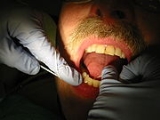
Oral hygiene
Overview
Oral hygiene
Teeth cleaning is part of oral hygiene and involves the removal of dental plaque from teeth with the intention of preventing cavities , gingivitis, and periodontal disease. People routinely clean their own teeth by brushing and interdental cleaning, and dental hygienists can remove hardened...
and involves the removal of dental plaque
Dental plaque
Dental plaque is a biofilm, usually a pale yellow, that develops naturally on the teeth. Like any biofilm, dental plaque is formed by colonizing bacteria trying to attach themselves to a smooth surface...
from teeth with the intention of preventing cavities
Dental caries
Dental caries, also known as tooth decay or a cavity, is an irreversible infection usually bacterial in origin that causes demineralization of the hard tissues and destruction of the organic matter of the tooth, usually by production of acid by hydrolysis of the food debris accumulated on the...
(dental caries), gingivitis
Gingivitis
Gingivitis is a term used to describe non-destructive periodontal disease. The most common form of gingivitis is in response to bacterial biofilms adherent to tooth surfaces, termed plaque-induced gingivitis, and is the most common form of periodontal disease...
, and periodontal disease
Periodontal disease
Periodontitis is a set of inflammatory diseases affecting the periodontium, i.e., the tissues that surround and support the teeth. Periodontitis involves progressive loss of the alveolar bone around the teeth, and if left untreated, can lead to the loosening and subsequent loss of teeth...
. People routinely clean their own teeth by brushing
Toothbrush
The toothbrush is an oral hygiene instrument used to clean the teeth and gums that consists of a head of tightly clustered bristles mounted on a handle, which facilitates the cleansing of hard-to-reach areas of the mouth. Toothpaste, which often contains fluoride, is commonly used in conjunction...
and interdental cleaning
Interdental brush
An interdental brush, also called an interproximal brush or a proxy brush, is a small brush, typically disposable and supplied with a reusable angled plastic handle, used for cleaning between teeth and between the wire of dental braces and the teeth. Brushes are available in a range of...
, and dental hygienist
Dental hygienist
thumb|right|300px|Dental hygienist holding a scalerA dental hygienist is a licensed dental professional who specializes in preventive oral health, typically focusing on techniques in oral hygiene. Local dental regulations determine the scope of practice of dental hygienists...
s can remove hardened deposits not removed by routine cleaning. Those with dentures
Dentures
Dentures are prosthetic devices constructed to replace missing teeth, and which are supported by surrounding soft and hard tissues of the oral cavity. Conventional dentures are removable, however there are many different denture designs, some which rely on bonding or clasping onto teeth or dental...
and natural teeth may supplement their cleaning with a denture cleaner
Denture cleaner
Denture Cleaner, also known as denture cleanser, is a cleaner used to assist in denture cleaning. Chemical denture cleaners can come in cream, liquid, powder or tablet format. Some chemical denture cleaners are effervescent and others are not...
.
Careful and frequent brushing with a toothbrush
Toothbrush
The toothbrush is an oral hygiene instrument used to clean the teeth and gums that consists of a head of tightly clustered bristles mounted on a handle, which facilitates the cleansing of hard-to-reach areas of the mouth. Toothpaste, which often contains fluoride, is commonly used in conjunction...
helps to prevent build-up of plaque
Dental plaque
Dental plaque is a biofilm, usually a pale yellow, that develops naturally on the teeth. Like any biofilm, dental plaque is formed by colonizing bacteria trying to attach themselves to a smooth surface...
bacteria on the teeth.

